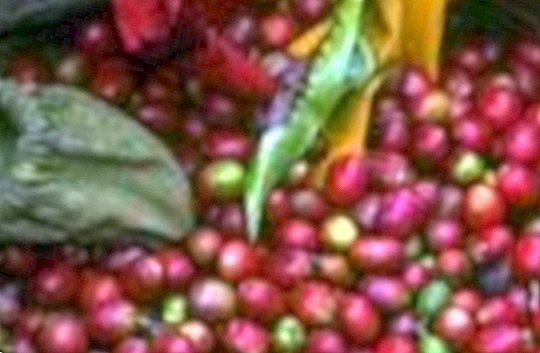Small coffee customer

facts and figures
- "C-a-f-f-e-e, do not drink so much coffee" - the warning from the old nursery rhyme we daily confidently in the wind - but every German citizen drinks about 160 liters of coffee per year. That makes a total of nearly 73 billion cups of coffee a year or so
- around 320 million cups a day. Thus, coffee is clearly the favorite German drink and ranked in the statistics even before beer (about 130 liters).
- The total world production of coffee is 85 to 100 million sacks of 60 kilograms per year. Around 75 million bags of green coffee per year are exported.
coffees

Plantation in Guatemala
Originally the coffee tree comes from Africa, more precisely from Ethiopia. Meanwhile, coffee is grown in more than 50 tropical and subtropical countries, the so-called coffee belt. The main varieties are Arabica and Robusta. Coffea Arabica accounts for 61 percent of world coffee production, followed by Coffea Canephora (Robusta) with approximately 39 percent. The two species form the basis for the approximately 700 different varieties.
cultivation

Coffee picker at work.
The most significant acreages are in South America (4.8 million hectares), Africa (3.8 million hectares), North and Central America (1.5 million hectares) and Asia (1.2 million hectares). Particularly valuable are coffee that grow in high altitudes. These so-called highland coffees, exclusively Arabicas, are characterized by a particularly fine acidity and an outstanding taste due to the special growth conditions.
Harvesting and processing

Coffee harvest in Costa Rica
In regions north of the equator, it is mostly harvested from September to December, to the south mainly from April / May to August. For the best coffee, only the ripe cherries are picked individually by hand. The red "coffee cherries" each contain two seed kernels, the coffee beans, which are extracted from the cherries by special processes (either traditionally by drying or by more elaborate wet processes).
export

The coffee cherries are dried for 3 to 5 weeks until the beans can be peeled out.
Coffee comes to 95 percent as raw coffee, so unroasted, to us. Brazil and Colombia are the largest coffee exporting countries with up to 45 percent. Other important states are Indonesia, Guatemala, Uganda, Mexico, Vietnam, Ivory Coast, Costa Rica, El Salvador, Ethiopia and Kenya.
roasting

Coffee beans before and after roasting.
Before we can buy our usual pound of coffee in the store, the beans still need to be roasted and mixed. Only when roasting, when the coffee beans are heated in 400 to 600 degrees hot air, creates the typical coffee aroma and also the taste. The beans lose most of their moisture and change color to dark brown. Until the 20th century coffee was mainly roasted privately in the households. Today, this happens in modern large roasting plants. Roasting time and temperature determine the taste of the coffee in a very significant way.
The aroma

coffee sample
Hard to believe: roasted coffee is one of the most flavored foods. It is composed of many hundreds of ingredients - mainly volatile essential oils. Up to 800 different flavors are said to be in roasted coffee - a reason why chemists have not yet succeeded in producing artificial coffee flavor. A roasted coffee mixture usually consists of 5 to 10 different green coffee provenies, which together should give the most consistent flavor possible. Coffee varieties of different origin, variety and quality must therefore be well coordinated - each delivery is therefore tested by the coffee verifiers on their individual tastes.
caffeine
The coffee bean contains carbohydrates, fatty substances, water, vegetable acids, minerals and aromatic substances. But the most important stuff we drink coffee for is caffeine. This is a so-called alkaloid, (nitrogen-containing substance), which depending on the variety can make up between 0.8 and 2.5 percent. A cup of coffee, for example, contains 50 to 150 milligrams of caffeine, depending on the type and strength of coffee.
Well dosed it acts as a wake-up agent, increases the pulse, activates the circulation in the brain, stimulates the nervous system and accelerates metabolism and respiration. Because caffeine also stimulates kidney activity and thus the urinary excretion, it is recommended to drink a glass of water with every cup of coffee.
Too much good - overdosing can cause shivers, palpitations, high blood pressure, tremors, dizziness and nausea. For such increased caffeine intake from about 250 mg, however, you would have to drink about eight cups of strong coffee in quick succession.And as an athlete you would have been disqualified for doping for a long time: Caffeine is also on the doping list of the International Olympic Committee: From a concentration of more than 12 mg per liter in urine (about six cups of coffee), the test is positive - even at Chess players.
preparation

The quality of a cup of coffee is determined by many different factors, such as mixing, roasting, grind, dosage, water quality, brewing temperature and service life. It is important that the coffee is used in the grinding suitable for the coffee machine. If it is too fine, the coffee is too strong in taste, it is too coarse, there is too thin coffee, because the flavors can not release.
pouring methods
Filter coffee: Hot water is poured onto the coffee in the filter bag and drips through the filter paper into the pot. Espresso: Hot steam is pressed through the coffee grounds. Turkish coffee: The coffee grounds are poured in the pot with hot water. The best way to prepare the coffee is purely a matter of taste.
storage
Coffee should be stored dry and cool so that the aroma remains as long as possible. Experts even advise to keep the coffee and its packaging in a storage container in the refrigerator.










